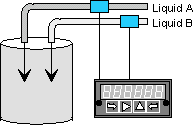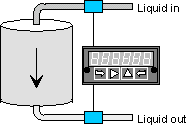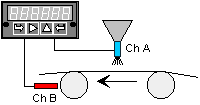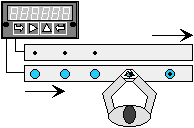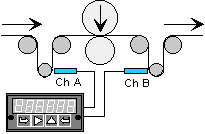

- DC Panel Meter
- Temperature Meter
- Process & Strain Meter
- Linearizing Meter
- True AC RMS Meter
- Load Cell & Microvolt Meter
- Scale / Weight Meter
- Frequency Counter, Rate Meter, Period Meter
- Process Receiver & Integrating Totalizer (analog input)
- Time Interval & Stopwatch
- Quadrature Position & Rate
- Batch Controller (analog input)
- 6-Digit Remote Displays
- Setpoint Controller Options
- AC & DC Power Options
- Analog Output Option
- Compact 1/8 DIN Case | RS-232 & RS-485 Options
- BCD Output Option
- Modbus Transmitters
- 4-20 mA Transmitters
- DC Voltage Transmitters
- Dual Chanel Frequency Transmitters
- Serial Input Transmitters
- Duty Cycle Transmitters
- DC Voltage Transmitters
Sum, Difference, Ratio, Product for Rate or Total with 2 Input Channels
- Isolated 4-20 mA or 0-10V transmitter outputs, selectable.
- Two independently field-scalable pulse input channels.
- Applicable arithmetic functions: A+B, A-B, AxB, A/B, A/B-1 (draw).
- Inputs from NPN or PNP proximity switches, contact closures, digital logic, magnetic pickups down to 12 mV, or AC inputs up to 250 Vac
- Square root extraction standard.
- DIN rail mount package only 22.5 mm thick.
- Easy setup using Laurel's PC-based Instrument Setup Software.
- Output resolution: 0.025% of span (12 bits).
- Internal conversion of Channel A & B inputs to six-digit readings:
- Digital span adjust from 0 to ±999,999. - Digital zero adjust from -999,999 to +999,999. - Frequencies from 0.005 Hz to 1 MHz.
- High output update rate.
- Isolated 5V, 10V or 15V dc excitation output to power transducers.
- Detachable screw clamp plug connectors.
- Optional dual solid state relays for alarm or control.
Sum can be used to add two flows for total flow, or to add parts carried by two conveyor belts.
Difference can be used to subtract outflow from inflow for net flow, or to subtract reject parts from total parts.Product can be used to multiply two rates, for example to compute horsepower by multiplying torque by RPM.
Ratio can be used to compare flow rates in two channels, the RPM of rollers or gears, or the speed of moving machinery, such as conveyor belts. Ratio can also be applied to scaled totals to compare two batches to be mixed. In this application, one transmitter is used to monitor the ratio of flow rates, and a second transmitter to monitor the resulting batch totals.Draw is obtained by subtracting 1 from ratio. Draw is used to measure the elongation of material as it passes between rollers, or to monitor variation in the speed of rollers for tensioning.
The output of the transmitters presented in this web page can be selected as 4-20 mA or 0-10V and is isolated to avoid ground loops. This output is generated by an ultra-linear 12-bit (4096 step) digital-to-analog convert (DAC), whose output span can be adjusted from 0 to ±999,999 input counts and zero can be adjusted from -999,999 to +999,999 input counts. The analog output has a rated accuracy of ±0.05% of output span.
The update rate of the analog output is a programmed gate time + 30 ms + 0-2 signal periods. For a 60 Hz signal, the update rate would be 20 per second. Such fast update rates are ideal for alarm and control applications.Transmitter programming is via a three-terminal RS-232 port using Laurel's PC-based Instrument Setup Software. This software can be downloaded from this website at no charge. The required transmitter-to-PC interface cable is available from Laurel (P/N CBL03).
The transmitters are housed in a DIN rail case that is only 22.5 mm (0.89") thick. Signal connections are via detachable screw clamp plug connectors.Specifications
| Pulse Input | |
| Types | AC, pulses from NPN, PNP transistors, contact closures, magnetic pickups. |
| Signal Ground | Common ground for channels A & B. |
| Channel A Frequency | 0.005 Hz to 1 MHz. |
| Channel B Frequency | 0.005 Hz to 250 kHz. |
| Minimum Signal | Nine ranges from (-12 to +12 mV) to (+1.25 to +2.1V). |
| Maximum Signal | 250 Vac |
| Noise Filter | 1 MHz, 30 kHz, 250 Hz (selectable). |
| Contact Debounce | 0, 3, 50 ms (selectable). |
| Time Base Accuracy | Quartz crystal calibrated to ±2 ppm. |
| Arithmetic Functions | A+B, A-B, AxB, A/B, A/B-1 |
| Transducer Excitation Output (standard) | |
| Jumper Selection 1 | 10V @ 60 mA, isolated to 50V from signal ground |
| Jumper Selection 2 | 5V @ 50 mA, isolated to 50V from signal ground |
| Jumper Selection 3 | 15V @ 60 mA, non-isolated |
| Dual Relay Output (optional) | |
| Relay Type | Two solid state relays, SPST, normally open, Form A |
| Load rating | 120 mA at 130 Vac or 170 Vdc, 28 ohms series resistance. |
| Analog Output (optional) | |
| Output Levels | 4-20 mA and 0-10 Vdc (selectable) |
| Compliance, 4-20 mA | 10V ( 0-500 ohm load ) |
| Compliance, 0-10V | 2 mA ( 5 kOhm load ) |
| Output Resolution | 12 bits (4,096 steps) |
| Output Accuracy | ±0.05% of output span |
| Output Update Rate | Programmed gate time + 30 ms + 0-2 signal periods |
| Output Isolation | 250V rms working, 2.3 kV rms per 1 minute test |
| Power Input | |
| Standard power | 95-240V AC ±10% or 90-300V DC |
| Low power option | 12-30V AC or 10-48V DC |
| Frequency | DC or 47-63 Hz |
| Power Isolation | 250V rms working, 2.3 kV rms per 1 min test. |
| Mechanical | |
| Case Dimensions | 120 x 101 x 22.5 mm |
| Case Mounting | 35 mm rail per DIN EN 50022 |
| Electrical Connections | Detachable screw clamp plug connectors |
| Environmental | |
| Operating Temperature | 0°C to 70°C |
| Storage Temperature | -40°C to 85°C |
| Relative Humidity | 95% at 40°C, non-condensing |
Typical Applications
Pulse Input for Frequency, Rate or Period
(shown with optional analog output and dual relay output)
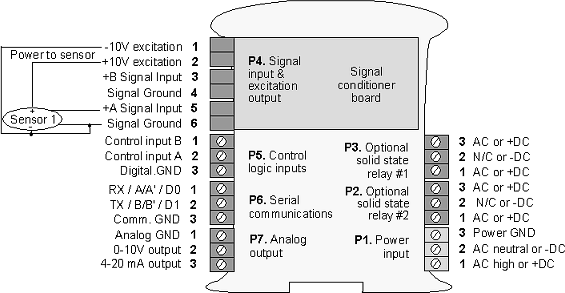 |
|
| Transmitter Powering a Single Sensor | |
 |
 |
| Transmitter Powering Two Sensors | Transmitter with Active or Passive Sensors |

